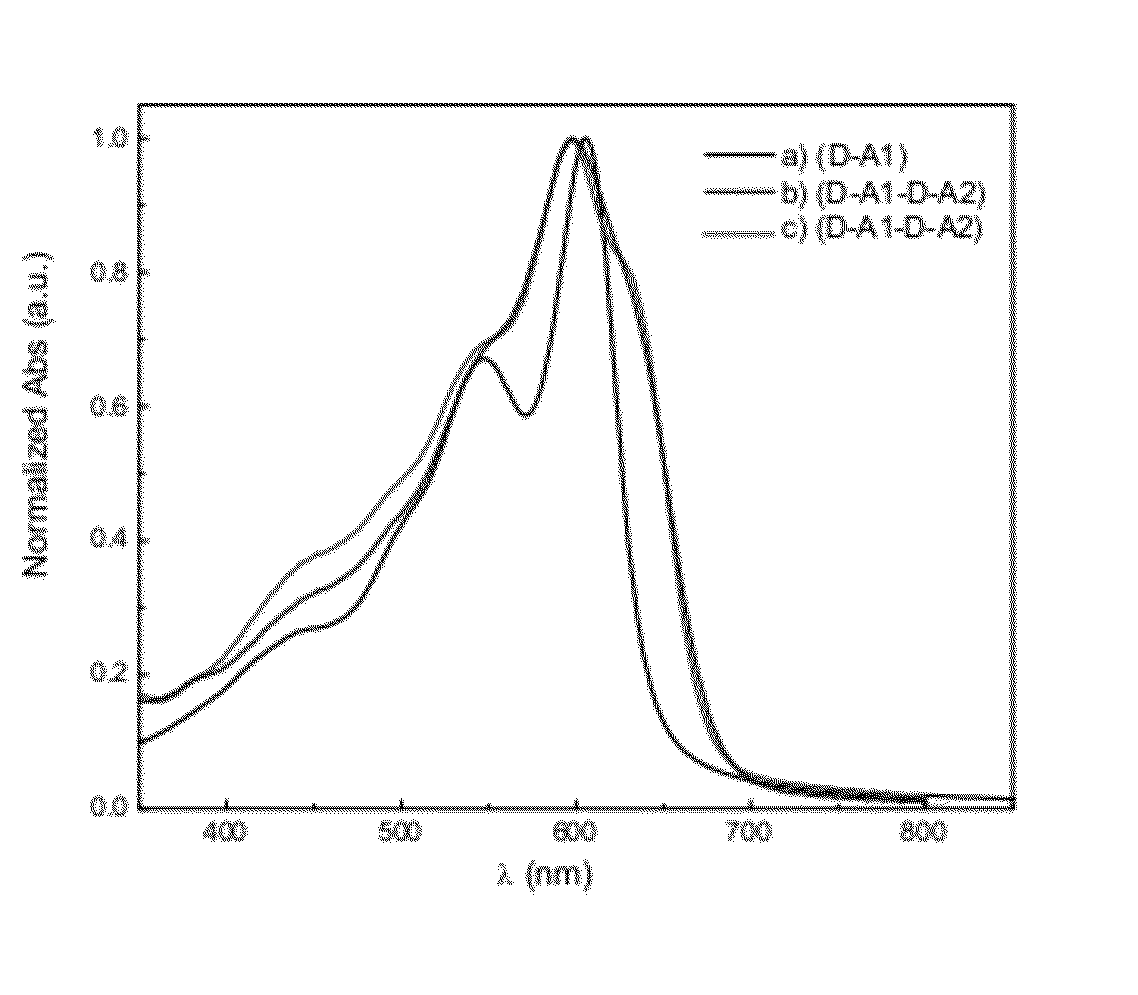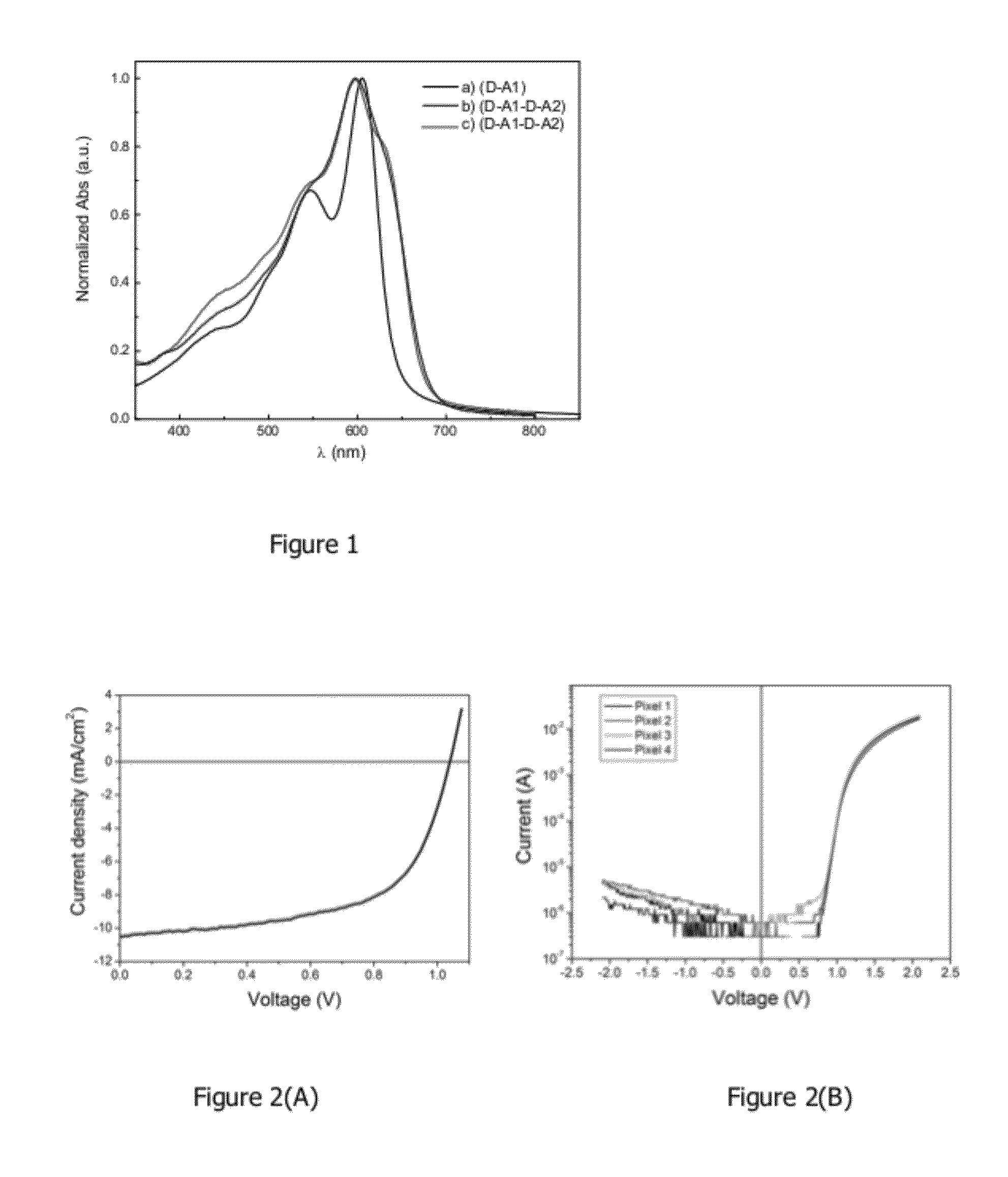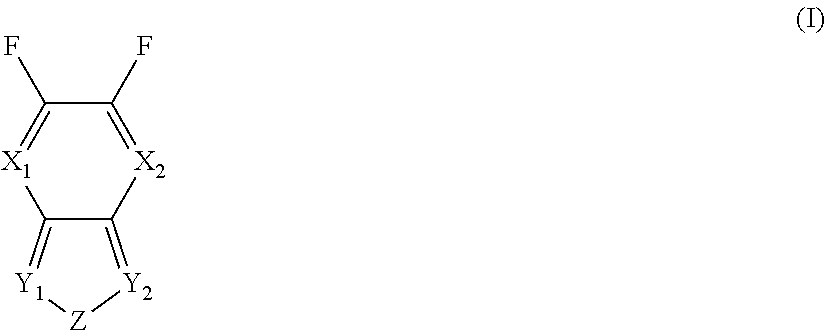Fluoro monomers, oligomers, and polymers for inks and organic electronic devices
a technology of which is applied in the field of fluoro monomers, oligomers, and polymers for inks and organic electronic devices, can solve the problems of not explaining how to make fluorinated monomers, sacrificing one, and difficulty in achieving fluorinated monomer combinations, etc., to achieve high photovoltaic efficiency, high photovoltaic efficiency, and large voc
- Summary
- Abstract
- Description
- Claims
- Application Information
AI Technical Summary
Benefits of technology
Problems solved by technology
Method used
Image
Examples
performance embodiments
Additional Embodiments Including High Performance Embodiments
[0083]Some embodiments provide particularly high performance in, for example, photovoltaic and / or solar cell testing including excellent power conversion efficiency and open circuit voltage. See, for example, working examples below and devices prepared therefrom and polymers used in the devices. The embodiments comprise, for example, monomers, oligomers, polymers, inks, devices, and methods of making and using same.
[0084]For example, one embodiment provides a device comprising: at least one cathode; at least one anode; at least one photovoltaic active layer disposed between the cathode and anode and comprising at least one p-type material and at least one n-type material, wherein the p-type material comprises at least one polymer comprising a donor-acceptor structure, comprising a second acceptor backbone moiety:
wherein R comprises a solubilizing group; and wherein the donor comprises at least one benzodithiophene structur...
working examples
Part IV. Working Examples
[0179]Additional embodiments are provided in the following working examples.
Synthesis: Monomers and Polymers
[0180]The following synthetic examples are illustrative and not intended to be limiting. Unless specified, reactions were conducted under prepurified nitrogen or argon, using oven-dried and / or flame-dried glassware. Ice / water, dry ice / acetone were used for 0° and −78° C. baths, respectively. Commercial chemicals were purchased from Aldrich Chemical Co., Inc. and used without further purification. Titration of the Grignard / organolithium reagents was performed following the procedure described by Love, et al. J. Org. Chem. 1999, 64, 3755.
Materials.
[0181]Syntheses of the following materials were adapted from the published procedures:[0182][4,8-bis(3-ethylheptyl)-6-trimethylstannyl-thieno[2,3-f]benzothiophen-2-yl]-trimethyl-stannane [Plextronics Patent Application on Organic Electronic Devices and Polymers, Including Photovoltaic Cells and Diketone-Based P...
example 1
Synthesis of 5,6-difluorobenzo[c][1,2,5]thiadiazole
[0187]
[0188]A dry 1000 mL round bottom flask, equipped with a condenser, was purged with nitrogen and charged with 4,5-difluorobenzene-1,2-diamine (10 g, 0.069 mol), 400 mL of anhydrous methylene chloride (CH2Cl2), and triethylamine (38.7 mL, 0.28 mol). The reaction flask was cooled to 0° C. and thionyl chloride (30.2 mL, 0.41 mol) was added drop-wise. The ice bath was removed and the mixture was heated to reflux for 1 hour. Completion of reaction was monitored by GC-MS. As the reaction was completed, the mixture was concentrated down, quenched with cold water, and extracted with CH2Cl2 (3×300 mL). The organic phase was dried over anhydrous MgSO4, filtered, and concentrated down. The final product was purified using column chromatography on silica gel with hexanes / ethyl acetate (80:20) gradient to yield white crystalline solid (6.3 g, 53%). Spectral data: 1H NMR (300 MHz, CDCl3): δH 7.75 (t, 2H).
PUM
| Property | Measurement | Unit |
|---|---|---|
| Voc | aaaaa | aaaaa |
| Voc | aaaaa | aaaaa |
| Voc | aaaaa | aaaaa |
Abstract
Description
Claims
Application Information
 Login to View More
Login to View More - R&D
- Intellectual Property
- Life Sciences
- Materials
- Tech Scout
- Unparalleled Data Quality
- Higher Quality Content
- 60% Fewer Hallucinations
Browse by: Latest US Patents, China's latest patents, Technical Efficacy Thesaurus, Application Domain, Technology Topic, Popular Technical Reports.
© 2025 PatSnap. All rights reserved.Legal|Privacy policy|Modern Slavery Act Transparency Statement|Sitemap|About US| Contact US: help@patsnap.com



